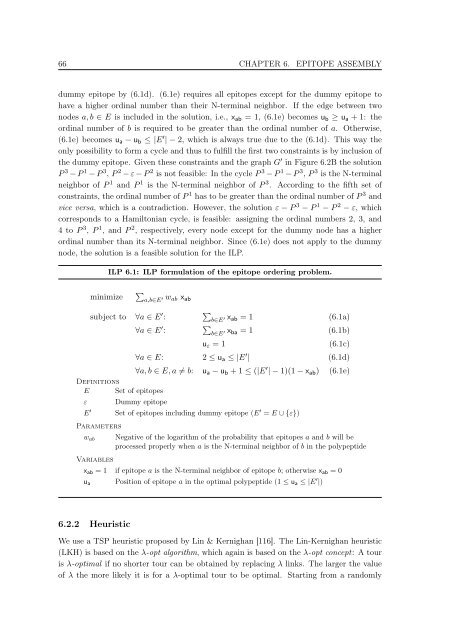New Approaches to in silico Design of Epitope-Based Vaccines
New Approaches to in silico Design of Epitope-Based Vaccines
New Approaches to in silico Design of Epitope-Based Vaccines
Create successful ePaper yourself
Turn your PDF publications into a flip-book with our unique Google optimized e-Paper software.
66 CHAPTER 6. EPITOPE ASSEMBLY<br />
dummy epi<strong>to</strong>pe by (6.1d). (6.1e) requires all epi<strong>to</strong>pes except for the dummy epi<strong>to</strong>pe <strong>to</strong><br />
have a higher ord<strong>in</strong>al number than their N-term<strong>in</strong>al neighbor. If the edge between two<br />
nodes a, b ∈ E is <strong>in</strong>cluded <strong>in</strong> the solution, i.e., xab = 1, (6.1e) becomes ub ≥ ua + 1: the<br />
ord<strong>in</strong>al number <strong>of</strong> b is required <strong>to</strong> be greater than the ord<strong>in</strong>al number <strong>of</strong> a. Otherwise,<br />
(6.1e) becomes ua − ub ≤ |E ′ | − 2, which is always true due <strong>to</strong> the (6.1d). This way the<br />
only possibility <strong>to</strong> form a cycle and thus <strong>to</strong> fulfill the first two constra<strong>in</strong>ts is by <strong>in</strong>clusion <strong>of</strong><br />
the dummy epi<strong>to</strong>pe. Given these constra<strong>in</strong>ts and the graph G ′ <strong>in</strong> Figure 6.2B the solution<br />
P 3 − P 1 − P 3 , P 2 − ε − P 2 is not feasible: In the cycle P 3 − P 1 − P 3 , P 3 is the N-term<strong>in</strong>al<br />
neighbor <strong>of</strong> P 1 and P 1 is the N-term<strong>in</strong>al neighbor <strong>of</strong> P 3 . Accord<strong>in</strong>g <strong>to</strong> the fifth set <strong>of</strong><br />
constra<strong>in</strong>ts, the ord<strong>in</strong>al number <strong>of</strong> P 1 has <strong>to</strong> be greater than the ord<strong>in</strong>al number <strong>of</strong> P 3 and<br />
vice versa, which is a contradiction. However, the solution ε − P 3 − P 1 − P 2 − ε, which<br />
corresponds <strong>to</strong> a Hamil<strong>to</strong>nian cycle, is feasible: assign<strong>in</strong>g the ord<strong>in</strong>al numbers 2, 3, and<br />
4 <strong>to</strong> P 3 , P 1 , and P 2 , respectively, every node except for the dummy node has a higher<br />
ord<strong>in</strong>al number than its N-term<strong>in</strong>al neighbor. S<strong>in</strong>ce (6.1e) does not apply <strong>to</strong> the dummy<br />
node, the solution is a feasible solution for the ILP.<br />
m<strong>in</strong>imize<br />
ILP 6.1: ILP formulation <strong>of</strong> the epi<strong>to</strong>pe order<strong>in</strong>g problem.<br />
<br />
a,b∈E ′ wab xab<br />
subject <strong>to</strong> ∀a ∈ E ′ :<br />
∀a ∈ E ′ :<br />
<br />
b∈E ′ xab = 1 (6.1a)<br />
<br />
b∈E ′ xba = 1 (6.1b)<br />
uε = 1 (6.1c)<br />
∀a ∈ E: 2 ≤ ua ≤ |E ′ | (6.1d)<br />
∀a, b ∈ E, a = b: ua − ub + 1 ≤ (|E ′ | − 1)(1 − xab) (6.1e)<br />
Def<strong>in</strong>itions<br />
E Set <strong>of</strong> epi<strong>to</strong>pes<br />
ε Dummy epi<strong>to</strong>pe<br />
E ′ Set <strong>of</strong> epi<strong>to</strong>pes <strong>in</strong>clud<strong>in</strong>g dummy epi<strong>to</strong>pe (E ′ = E ∪ {ε})<br />
Parameters<br />
wab<br />
Variables<br />
Negative <strong>of</strong> the logarithm <strong>of</strong> the probability that epi<strong>to</strong>pes a and b will be<br />
processed properly when a is the N-term<strong>in</strong>al neighbor <strong>of</strong> b <strong>in</strong> the polypeptide<br />
xab = 1 if epi<strong>to</strong>pe a is the N-term<strong>in</strong>al neighbor <strong>of</strong> epi<strong>to</strong>pe b; otherwise xab = 0<br />
ua<br />
6.2.2 Heuristic<br />
Position <strong>of</strong> epi<strong>to</strong>pe a <strong>in</strong> the optimal polypeptide (1 ≤ ua ≤ |E ′ |)<br />
We use a TSP heuristic proposed by L<strong>in</strong> & Kernighan [116]. The L<strong>in</strong>-Kernighan heuristic<br />
(LKH) is based on the λ-opt algorithm, which aga<strong>in</strong> is based on the λ-opt concept: A <strong>to</strong>ur<br />
is λ-optimal if no shorter <strong>to</strong>ur can be obta<strong>in</strong>ed by replac<strong>in</strong>g λ l<strong>in</strong>ks. The larger the value<br />
<strong>of</strong> λ the more likely it is for a λ-optimal <strong>to</strong>ur <strong>to</strong> be optimal. Start<strong>in</strong>g from a randomly

















